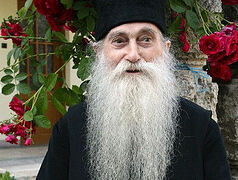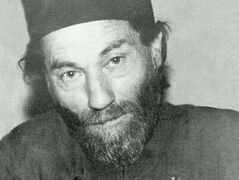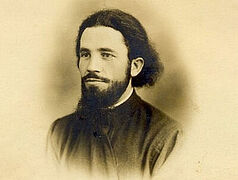By the decision of the Holy Synod of the Romanian Orthodox Church on July 11–12, 2024, sixteen God-pleasing ascetics who shone with holiness of life in the twentieth century were canonized as saints. One of them is the priest Ilie Lăcătușu, who will be henceforth known as the Holy Confessor Fr. Ilie Lăcătușu. The saint will be commemorated on July 22.
 Priest Ilie Lăcătușu Those who weren’t afraid to confess God even under the fear of the cruelest tortures have shone like bright luminaries at the times of godless persecution of the twentieth century. The blood of martyrs streamed then just like it did during the first centuries of Christianity.
Priest Ilie Lăcătușu Those who weren’t afraid to confess God even under the fear of the cruelest tortures have shone like bright luminaries at the times of godless persecution of the twentieth century. The blood of martyrs streamed then just like it did during the first centuries of Christianity.
The Church in Romania was also hit hard with persecution of believers. Bishops, priests and laity defended their greatest treasure of having the right faith at the cost of their lives. Many prominent fathers-confessors and renowned theologians passed through the prison underworld. But instead of resigning themselves their fate, they came out of their ordeal stronger, hardened, and eager to preach the true faith.
Father Ilie Lăcătușu stands apart in their midst. His whole life was dedicated to God. He was born on December 6, 1909 in the village of Crapaturile in Valcea County, into a family of devout Christians. His parents, Marin and Maria Lăcătușu, were constantly present at their church, where his father served as a cantor. Ilie spent his childhood in the village, and the pastoral beauty of peasant life opened his heart to God so much that he, though young, was already aflame with desire to serve Him with all his being.
In 1922–1930, he studied at the St. Nicholas Seminary in Valcea, where his extraordinary abilities showed themselves. In 1930–1934, he studied at the theological faculty of the University of Bucharest, where his teachers were outstanding figures of religious life of the time. In March 1931, he married Ekaterina Popescu, a teacher from the village of Cordesti in Gorj County. In September 1934, he was ordained a priest and sent to the parish in the village of Osica de Jos in Olt County, only later to be transferred to the village of Buicesti in Mehedinti County. During all these years Father Ilie led a quiet life, dedicating all his strength to his priestly ministry and his family, which God blessed with five children.
 Incorrupt relics of Father Ilie Lăcătușu From the summer of 1942 until the spring of 1943, Father Ilie was sent by the Romanian Orthodox Mission to preach beyond the River Prut in Odessa, and later to the parish of Sersenica in Transnistria.1 In 1952, a wave of arrests swept the clergy, and Father Ilie ended up at the Galesu labor camp, building the “Danube-Black Sea” Canal. Then he was moved to the Peninsula camp in Constanta. From September 1953 to April 1954, he stayed in labor unit 0680 stationed in the city of Onesti.
Incorrupt relics of Father Ilie Lăcătușu From the summer of 1942 until the spring of 1943, Father Ilie was sent by the Romanian Orthodox Mission to preach beyond the River Prut in Odessa, and later to the parish of Sersenica in Transnistria.1 In 1952, a wave of arrests swept the clergy, and Father Ilie ended up at the Galesu labor camp, building the “Danube-Black Sea” Canal. Then he was moved to the Peninsula camp in Constanta. From September 1953 to April 1954, he stayed in labor unit 0680 stationed in the city of Onesti.
In 1954, the communist authorities eased persecution and thus Father Ilie was released. But in 1959 the persecution intensified again, and he was sentenced to forced labor in the Delta in the Periprava high-security labor camp. Due to the inhumane conditions in this camp, Fr. Ilie’s health was seriously compromised.
 A line to enter the vault of the Lăcătușu family to venerate the incorrupt relics of Fr. Ilie
A line to enter the vault of the Lăcătușu family to venerate the incorrupt relics of Fr. Ilie
On May 6, 1964, Father Ilie was forced to remain in the village of Bolintin. Later on, from December 20, 1964 to August 1, 1970, he served in the parish of Gardesti. Then he was transferred to the Cucuruzu parish in the village of Rasuceni, and this was where he went into retirement at the beginning of 1978.
When he was staying in the hospital in 1983, Father Ilie said that if he is still alive on July 22, he would live for two more years. He also wished that if his wife died fifteen years after him, she were to be buried next to him. And he died exactly on July 22, while fifteen years later, in 1998, his wife Presbytera Ekaterina also reposed.
On September 29, 1998, at her burial, something unheard of happened: The body of Father Ilie was found completely untouched by decay, exuding fragrance.
 Incorrupt relics of Father Ilie Lăcătușu
Incorrupt relics of Father Ilie Lăcătușu
In order to make sure that the body of the priest remained incorrupt for reasons other than biological ones, the family members, in agreement with a local priest, decided against burying the body in its original place, but placed it in the open air. However, even after nine weeks had passed, it had not suffered any changes.
May the Lord, Who arranges it all, enlighten us so that we can perceive how He accepted His confessor in heaven.
Editorial Board of the magazine
“Vestitorul Ortodoxiei” (“Orthodox Herald”)
The body of Fr. Ilie Lăcătușu was found perfectly intact
At my parish in the village of Giulesti, I ministered to Presbytera Ekaterina Lăcătușu, a woman of great spiritual strength. She had been a widow for almost twelve years and said that God bestowed upon her the happiness to live with a truly special servant of God. Presbytera went to confession and received Holy Communion, and she and I had unforgettable conversations. But then came the time for her to depart unto the Lord. So, she was buried on September 29, 1998, after receiving the proper Christian last rites.
 Fr. Ilie Lăcătușu with his wife and a child
Fr. Ilie Lăcătușu with his wife and a child
Fr. Ilie Lăcătușu left his will to her that should she die fifteen years after him, his grave was to be opened and she was to be laid next to the reverend father. His wish was fulfilled, and after his wife’s death, his grave was opened in order to place Presbytera next to him. But when we opened the grave to inter the reposed Ekaterina Lăcătușu, we decided to open his coffin to arrange his remains according to the existing custom before placing them next to his wife. But at that moment they found that the body of Father Lăcătușu remained completely incorrupt; moreover it was very light and exuded a pleasant fragrance.
Since special procedures were now required for his burial, we left the body of the priest lying on the ground level in the niche of the crypt in order to figure out what to do next. Six weeks later, we came again to serve the Pannikhida service for the reposed Presbytera Ekaterina and found that his body had not suffered any changes.
Then, at his family’s suggestion, we moved on to the next stage—preparing the Fr. Ilie’s body by washing and vesting it in new vestments. In order to make sure that everything was done according to the rules, the heirs first notified the highest levels of the Church, informed the Archdiocese of Bucharest, and then made a petition in my name that I was to wash Father’s body and dress him in new vestments.
I began to photograph every step of the procedure, as you can see here (he flips through the photo album on camera), and to dress him, first in a linen robe and later in the rest of the priestly vestments.
As a result of all that happened, we came to the conclusion that his body is absolutely incorruptible, it is weighs little, is very light, and there is no unpleasant odor. On the contrary, the body exudes a pleasant fragrance.
Priest Nicolae Barbu
 The icon of the Holy Confessor Fr. Ilie Lăcătușu painted by the sisters of the Diaconesti monastery On July 23, 2008, the following important information appeared on one website:
The icon of the Holy Confessor Fr. Ilie Lăcătușu painted by the sisters of the Diaconesti monastery On July 23, 2008, the following important information appeared on one website:
“The heirs of Father (Ilie Lăcătușu) ask the clergy and hierarchs who serve in the country and abroad to hold services for the forgiveness of his sins.”
Beginning from May 1, 1999, such services for the forgiveness of his sins were held for forty days after the holy Liturgy in the Frasinei Monastery. At the Pannikhida service one year after the discovery of his remains, His Grace Teodosie of Snagov read a hierarchical prayer over them for the absolution of the deceased from possible great sins or anathemas that might have prevented the body of the priest from decaying. On February 6, 2000, Metropolitan Serafim (Joanta) of Central and Northern Europe celebrated a divine service with the addition of prayers for the absolution of his sins. However, Father’s body remained incorrupt, and the Romanian Patriarchate began to put together the documents for his canonization.
Officially, not a single refutation of the beginning of preparations for canonization were released. On the contrary, the news was later confirmed by Father Costel Stoica, spokesman of the Romanian Patriarchate, who stated:
“Father Ilie is on the list for future canonization. However, the Orthodox practice is such that we have no room for haste, so we don’t know when this (canonization) will take place.”
Great Romanian spiritual elders on the finding
of the relics of Fr. Ilia Lăcătușu
Fr. Ilie Lăcătușu had Christ in his life during the years of imprisonment, just as he lived in our midst. Having his holy faithfulness, he was vouchsafed to receive a great gift—to taste the Mystery of Resurrection, that is, incorruption and inheritance of eternal life.
Father Professor Dr. Constantin Galeriou
I was asked if Stefan the Great was going to be canonized. One hierarch used to visit me. I didn’t support such opinion. I stand rather for the canonization of Father Ilie Lăcătușu, because there are signs from God for it—his body is incorrupt and exudes fragrance. You need to bring this to the attention of the Patriarchate. They should get things moving, even though it won’t be easy to rank him among the saints.2 After all, the most obvious and irrefutable thing is that his body didn’t experience decay. 3 He exudes fragrance. Everyone believes that he is a saint.
Archimandrite Arsenius (Papacioc)
The hierarchs of the Romanian Orthodox Church dare not declare that the remains of political prisoners who perished in prison for Christ’s sake are in fact relics. However, several cases have been brought to the Patriarchate with the aim of canonization. For example, the case of Father Ilie Lăcătușu, about whom I firmly believe that he is a saint, and Valeriu Gafencu. The Synod hasn’t yet issued any commentary on this matter. The former political prisoners were mostly Legion members and the hierarchs fear that their decision will be interpreted politically. We need to treat this issue wisely and carefully. If God wills, He can do us good even through the saints unknown to us, whom we haven’t recognized as such.
Fr. Gheorghe Calciu-Dumitreasa
We must venerate Father Ilie as a saint because his case is a strong argument against materialism and idolatrous delusion. We can address him in our prayers at any time, because the saints are an indisputable testimony to the existence of Orthodox life even during the times like those we live in today. We can paint his icons, or we can build his shrine, as for St. John the New of Suceava and St. Parascevi. We, as well as the whole Christian world, should mark his commemoration day (July 22). We can stand proudly before other nations, the Protestants, or the Catholics, as we have these God-pleasing saints: St. John James the Chosevite and St. Ilie Lăcătușu.
Beginning with the Pitesti prison, where the most brutal physical and moral tortures were used, and continuing with the rest of the prisons and concentration camps in our country, whose purpose was the destruction of faith and man, Romania has delivered one of the greatest sacrifices for the sake of defense of the right faith and our people. Priest Ilie Lăcătușu was a devoted servant of Christ. Originally from Valcea County, he spent more than a year in prisons and suffered as a martyr. In the fall of 1998, fifteen years after his death, he was found in his grave completely incorrupt, as a sign that God had accepted his sacrifice and counted him among the righteous.
Archimandrite Ioanichie (Balan)
“Nothing is said about the new martyrs of our Church. You know, there were so many of them in communist prisons; and now we have found a priest whose body is incorrupt.”
“Just think of it!”
“Yes, it is Fr. Ilie Lăcătușu. Yet they keep quiet about him. What are we to do now?”
“You see? This is the scheming of the devil. So, you see how evil made progress here? God obviously revealed him as a saint after death, and yet, lo and behold, our leaders don’t take steps to canonize him and recognize that the tribulations and agonies he had endured sanctified him. That’s true, yes, but they don’t have the nerve to do that. So, do you understand what we have come to?”
“And nothing is said about all those who suffered in the prisons. But we had so many martyrs there! Maybe we had even more now, in this century, than during the first three centuries!”
“Of course, yes! See, the goal of the devil is this—to keep the truth from being preached. See? But God made them holy and they rest there, in the never-ending life, where they will rejoice along with the angels of God and all the holy martyrs who suffered for Christ. The human race is like this.”
Elder Dionisie of Colciu cell
“All signs speak of the holiness of Fr. Ilie. His veneration among the people and the way they revere his relics serve as a continuation of his holy preaching in his lifetime; they work to multiply faith and thus glorify God a thousand times more powerfully than when the reverend father was alive.
There were so many fine priests who, during their lifetime, nurtured holiness in their parishioners, and many of them suffered and died in prisons. But who remembers them now? Only their family and friends who are still alive. God invested in Fr. Ilie Lăcătușu something much greater: an incorrupt body, a holy fragrance, and especially, the power to preach the Word even after death thanks to the miracle God wrought on his body.”



